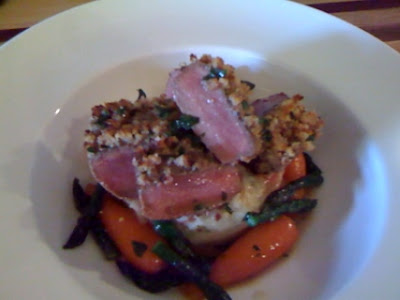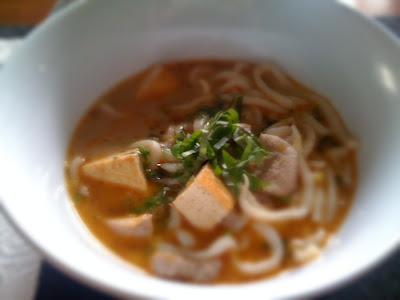A couple of important milestones were achieved here:
1) I made really well-formed spherical ravioli this time, having finally purchased some calcium chloride. These turned out much better then my 'reverse-spherification' attempts generally do.
2) Believe it or not, this is the first souffle I have ever made. And it rose. Evenly. And it stayed there even after spoons were hungrily thrust into it. You can't believe how happy that made me (and my guests!)
3) I put in some practice on making quenelles. You can see that it paid off with the strawberry sorbet. They are the best quenelles I have ever made. (If you are wondering, quenelles are the perfect football shape you can achieve with a spoon and a rather precise flick of the wrist.)

Spherical Ravioli of Chilled Asparagus Soup with Creme Fraiche and Confit Grapefruit Zest
SOUP BASE
1 pound green asparagus, cut in 2" pieces
2 ¼ cups Vegetable Broth
zest and juice of 1 orange
salt and black pepper
RAVIOLI OF ASPARAGUS SOUP
500 g soup base
2.3 g algin (sodium alginate)
CALCIC WATER BATH
500 g water
3.2 g calcic (calcium chloride)
CONFIT ZEST
6 strips grapefruit zest
2 tablespoons sugar
2 tablespoons water
GARNISH
creme fraiche, for garnish
coarse sea salt
SOUP BASE
In a large pot of boiling water, blanch the asparagus for 5 to 10 minutes or until fork tender. Drain and immediately submerge in cold water . Drain again.
Transfer about a quarter of the asparagus pieces to a blender and add about 1/2 cup of the stock. Puree until smooth. Pour into a larger bowl. Continue pureeing the remaining as asparagus and stock in batches. Strain through a chinois or fine-mesh sieve into the bowl.
Stir the orange zest and juice into the soup . Gently stir in more stock until the soup is the consistency you prefer. Season to taste with salt and pepper.
SPHERICAL RAVIOLI BASE
Add the algin to 1/3 of the soup mixture and whiz up with a hand-blender. Add the rest of the soup base and whiz through to combine. Cover and chill for at least 1 hour.
CALCIC BATH
Combine the calcic and water and whisk to combine. Set aside.
CONFIT ZEST
Boil the water. Add the sugar to the boiling water and cook until dissolved. Lower the heat all the way down and add the zest. Cook for 45 minutes. Drain and let dry on paper towels. Reserve.
FINISH
Squirt some ravioli base into a dipping spoon and submerge the spoon in the calcic bath. The 'ravioli' should free itself from the spoon within a few seconds. Let the sphere 'cook' in the calcic bath for 2 minutes, then lift out with a draining spoon, and put into a cold water bath to rinse off.
Put the sphere into a serving spoon. Top with a dot of creme fraiche or fromage frais. Top with a few strands of grapefruit zest confit and a few flakes of sea salt. Serve.

Tian of Brixton Scallop and Crab Mousse with Lemongrass and Ginger Sauce
TIAN
150 g shelled scallops
50 g brown crab meat
1 egg yolk
250 ml whipping cream
150 g white crabmeat
10 g fresh ginger, finely diced
pinch of cayenne pepper
juice of 1 lemon
2 large courgettes, sliced lengthways
salt and pepper
LEMONGRASS AND CORIANDER SAUCE
75 g shallots, chopped
25g fresh ginger, chopped
50 g fresh lemongrass, chopped
175 g unsalted butter
5 g white peppercorns
5 g coriander seeds
75 g brown crab meat
250 g crab carcasses
250 ml fish stock
chopped fresh coriander (optional)
GARNISH (OPTIONAL)
grapefruit segments
batons of fresh ginger
First prepare the sauce. In a stainless steel saucepan sweat the shallots, ginger and lemongrass in 75g of the butter for 5 minutes, without coloring. Add the peppercorns and coriander seeds and sweat for a further 2 minutes. Add the brown crabmeat and crab carcasses and sweat for 5 minutes longer. Pour in the fish stock, bring to the boil and cook for 20 minutes. Pass through a colander set over a bowl and then through a fine sieve. Reserve in a saucepan for later use.
To make the mousse, combine the scallops, brown crab meat, egg yolk and cream in a blender or food processor and blend until very fine and smooth. Remove from the blender and place in a bowl. Set over ice and mix in the white crab meat and ginger, then season with salt, pepper, cayenne and a dash of lemon juice. Set aside.
Preheat the oven to 180°C.
Warm six 6cm diameter metal rings, then wrap cling film tightly around the bottom half. Allow the rings to cool, then butter the insides with softened butter.
Blanch the courgettes in boiling water, then drain and pat dry on a cloth. Line the sides of the metal rings with the courgette ribbons. Set them in a baking tray. Fill the molds with the mousse.
Pour some hot water into the baking tray (no higher than the cling film wrapping) and cook in the oven for 8-10 minutes.
Meanwhile, to finish the sauce, warm it through, then whisk in the remaining butter and season with salt, pepper and a drop of lemon juice. Add the coriander.
To serve, turn out the mousses into the center of the warm plates, garnish with grapefruit segments and batons of ginger, if using, and drizzle the sauce around.

New-Season Lamb with Herb and Mustard Crust and Scallion Crushed Potatoes
LAMB
4x150 g boneless loins of lamb
4 tablespoons light olive oil
6 tablespoons fresh breadcrumbs
1 teaspoon thyme, roughly chopped
1 tablespoon parsley, chopped
1 tablespoon smooth strong Dijon mustard
1 tablespoon wholegrain Dijon mustard
salt and pepper
SAUCE
300 milliliters lamb stock, made from bones and trimmings
1 pinch thyme leaves
1 teaspoon parsley, chopped
1 teaspoon wholegrain Dijon mustard
15 g butter
SCALLION CRUSHED POTATOES
700 g new potatoes, peeled
85 g butter
4 scallion, finely chopped
GARNISH
seasonal vegetables, such as new carrots, braised lettuce, asparagus and/or broad beans
Preheat the oven to 200°C.
Season the lamb with salt and pepper. In a heavy frying pan, heat 3 tbsp of the olive oil until it is nearly smoking. Add the lamb and cook over high heat until well browned all over. This should take about 5 minutes; the loins should still be rare inside. Place on a wire rack and allow to cool to room temperature.
Pour the breadcrumbs on to a baking sheet and drizzle with the remaining olive oil. Mix gently with your fingers. Put into the oven and toast until lightly browned, stirring two or three times. When browned, allow to cool, then add the herbs.
For the sauce, reduce the lamb stock until it has a light sauce consistency.
To prepare the scallion crushed potatoes, cook the new potatoes in boiling salted water until tender, then drain. Melt the butter in a saucepan over a moderate heat, add the spring onions and a little salt and cook gently for 1 minute. Add the potatoes and crush gently with a fork. Keep warm.
While the potatoes are cooking, finish the lamb. Mix the two mustards together and brush over the top ofeach loin. Dip the mustard-coated part of the loin into the breadcrumbs and gently press the crumbs on to the mustard. Set the loins on a baking sheet, crumb side up. Place in the top of the oven and roast for 4-5 minutes for medium rare, or 8 minutes for medium well done. Remove from the oven and allow to rest in a warm place while you cook the vegetables and finish the sauce.
Bring the sauce to the boil, then remove from the heat and stir in the herbs, mustard and butter. Check for seasoning.
To serve, spoon the vegetable garnishes and scallion crushed potatoes on to the warmed plates. Slice each loin into three thick slices and place on the potatoes. Spoon the sauce over or around.

Strawberry Souffle with Strawberry Sorbet and Welsh Shortbread
SOUFFLE
500 g strawberries, hulled
150 g caster sugar, plus extra for dusting
1 vanilla pod, split lengthways
2 ½ tablespoons cornflour
soft butter for the dishes
4 egg whites
sifted icing sugar to dust
SORBET
100 g caster sugar
100 ml boiling water
500 g strawberries, hulled
SHORTBREAD
100 g soft slightly salted butter
45 g icing sugar, sifted
125 g plain flour
pinch of salt
To make the jam base for the souffle, blitz the strawberries and loog sugar in a food processor to a puree. Rub through a fine sieve into a heavy-bottomed pan. Scrape in the vanilla seeds from the pod. Bring to the boil over a medium heat, whisking continuously. Stir the cornflour with about 60 ml of water just to slacken, then whisk into the strawberry puree until the mixture thickens. Cool, then chill.
Brush the insides of four souffle dishes that are 9cm diameter and 6cm deep with softened butter. then dust with caster sugar. Chill.
To make the sorbet, dissolve the sugar in the boiling water, then simmer for about 2 minutes to make a sugar syrup. Cool. Blitz the strawberries with the syrup to a puree, and rub through a fine sieve into a bowl. Cool, then chill. Place in an ice cream maker and churn for 15-20 minutes to a soft scoop texture. Scoop out four neat quenelles and freeze them on a plate. (The rest of the sorbet can be kept in the freezer for up to 2 weeks.)
To make the shortbread, beat the butter and icing sugar together, then gently mix in the flour and salt to make a dough. Roll into a cylinder about 5-6cm in diameter, wrap in cling film and chill for at least 2 hours.
Preheat the oven to 200C/fan 180C. Cut the chilled dough into 5mm thick slices (12-14 slices) and place on a baking sheet. Bake for 10-12 minutes or until golden round the edges. Slide onto a wire rack to cool and crisp. Leave the oven on.
To finish the souffles, whisk the egg whites with the remaining 55g caster sugar to soft peaks. Fold into the souffle jam base. Divide the mixture among the four dishes. filling them to the top, then level with the back of a knife. Bake for 9-11 minutes or until risen above the rim by half.
Remove from the oven and immediately dust the tops with icing sugar. Set each souffle on a large plate. Put a frozen scoop of sorbet and a piece of shortbread to the side. Serve right away.









